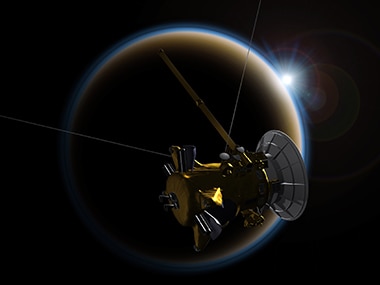NASA’s USD 3.9 billion Cassini spacecraft today ended its 20-year-long groundbreaking journey with a fiery plunge into the Saturn’s crushing atmosphere, beaming back never-before-seen images of the ringed planet and its mysterious moons until the last moment. Operators deliberately made Cassini, the first spacecraft to orbit Saturn, dive into the gas giant to ensure that the planets moons - **in particular Enceladus** , with its subsurface ocean and signs of hydrothermal activity - remain pristine for future exploration. “Our spacecraft has entered Saturn’s atmosphere, and we have received its final transmission,” NASA said in a tweet. “Every time we see Saturn in the night sky, well remember. Well smile. And well want to go back,” the US space agency said. The spacecrafts fateful dive was the final beat in the missions Grand Finale, 22 weekly dives, which began in late April, through the gap between Saturn and its rings.
Our spacecraft has entered Saturn's atmosphere, and we have received its final transmission.
— NASA Solar System (@NASASolarSystem) September 15, 2017
No spacecraft has ever ventured so close to the planet before, NASA said. “I hope you are all as deeply proud of this amazing accomplishment. Congratulations to you all. This has been an incredible mission, incredible spacecraft and you were all incredible team,” Earl Maize, Cassini mission manager, said while announcing the end of the mission at IST 5:25 pm. The USD 3.9 billion [caption id=“attachment_3865521” align=“alignleft” width=“380”]  Cassini in front of Titan. NASA[/caption] mission continued to transmit data back to the Earth till the last minute before it came apart and was burned up like a meteor in Saturns atmosphere. The unmanned orbiter tore through the atmosphere at the speed of 113,000 kilometres per hour. Contact was lost with the Cassini spacecraft a minute after it reached an altitude of about 1,500 kilometres above the planets estimated cloud tops. Within about 30 seconds following loss of signal, the spacecraft came apart; and within a couple of minutes, all remnants of the spacecraft were consumed in the atmosphere of Saturn, NASA said. “Earth received CassiniSaturns final signal at 7:55 am ET. Cassini is now part of the planet it studied. Thanks for the science,” NASA tweeted. The Cassini mission gave scientists an unprecedented view of the sixth planet from the Sun. The probe discovered seasonal changes on Saturn, a hexagon-shaped pattern on the north pole and the moon Titans resemblance to a primordial Earth.
Earth received @CassiniSaturn’s final signal at 7:55am ET. Cassini is now part of the planet it studied. Thanks for the science #GrandFinale pic.twitter.com/YfSTeeqbz1
— NASA (@NASA) September 15, 2017
Scientists found deep, liquid-filled canyons on Saturns moon Titan for the first time. They also found a global ocean on the moon Enceladus, with ice plumes spouting from its surface. Thanks to these observations, Enceladus has become a promising target in the search for life outside Earth. A joint endeavour of NASA, the European Space Agency (ESA) and the Italian space agency, Agenzia Spaziale Italiana (ASI), Cassini was a sophisticated robotic spacecraft orbiting the ringed planet and studying the Saturnian system in detail. The spacecraft has produced 450,000 images and 635 gigabytes of data since it began probing Saturn and its 62 known moons in July 2004. Cassini also carried a probe called Huygens, which parachuted to the surface of Saturns largest moon, Titan, in January 2005 and returned spectacular results. Launched in October 1997, Cassini completed its initial four-year mission to explore the Saturn system in June 2008, and the first extension, called the Cassini Equinox Mission, in September 2010. In a second extension called the Cassini Solstice Mission, the spacecraft made new exciting discoveries. Late last year, the Cassini spacecraft executed a **daring set of ring-grazing orbits** . The spacecraft repeatedly climbed high above Saturns poles, flying just outside its narrow F ring 20 times. After a last flyby of the Saturns moon Titan, the spacecraft dived between Saturns uppermost atmosphere and its innermost ring 22 times.


)



